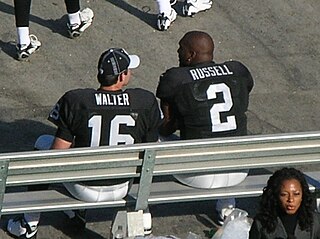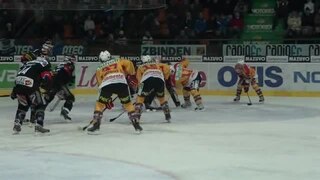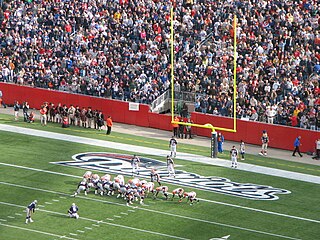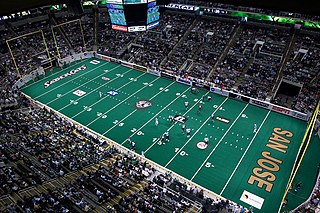
The end zone is the scoring area on the field, according to gridiron-based codes of football. It is the area between the end line and goal line bounded by the sidelines. There are two end zones, each being on an opposite side of the field. It is bordered on all sides by a white line indicating its beginning and end points, with orange, square pylons placed at each of the four corners as a visual aid. Canadian rule books use the terms goal area and dead line instead of end zone and end line respectively, but the latter terms are the more common in colloquial Canadian English. Unlike sports like association football and ice hockey which require the ball/puck to pass completely over the goal line to count as a score, both Canadian and American football merely need any part of the ball to break the vertical plane of the outer edge of the goal line.

In gridiron football, a line of scrimmage is an imaginary transverse line beyond which a team cannot cross until the next play has begun. Its location is based on the spot where the ball is placed after the end of the most recent play and following the assessment of any penalty yards.

Arena football is a variety of indoor gridiron football played by the Arena Football League (AFL) and China Arena Football League (CAFL). The game is played indoors on a smaller field than American or Canadian outdoor football, resulting in a faster and higher-scoring game. The sport was invented in 1981, and patented in 1987, by Jim Foster, a former executive of the National Football League and the United States Football League. The name is trademarked by Gridiron Enterprises and had a proprietary format until its patent expired in 2007. Due to the patent, other indoor American football leagues that launched following the popularity of the original AFL developed variants on the arena rules.

In sports, a goal is a physical structure or area where an attacking team must send the ball or puck in order to score points. In several sports, a goal is the sole method of scoring, and thus the final score is expressed in the total number of goals scored by each team. In other sports, a goal may be one of several scoring methods, and thus may be worth a different set number of points than the others.
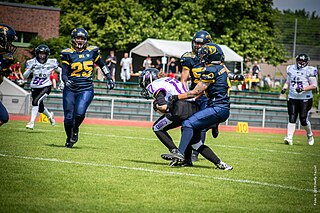
American and Canadian football are gridiron codes of football that are very similar. Both have their origins in rugby football. There are, however, some key differences.

United Indoor Football (UIF) was a United States indoor football league that started in 2005. Ten owners from the National Indoor Football League, including one expansion and two from arenafootball2 (af2) took their franchises and formed their own league. The league was based in Omaha, Nebraska.
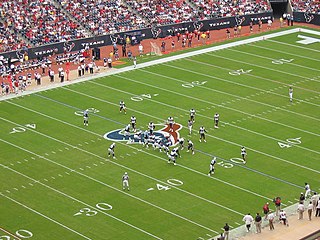
Game play in American football consists of a series of downs, individual plays of short duration, outside of which the ball is dead or not in play. These can be plays from scrimmage – passes, runs, punts, or field goal attempts – or free kicks such as kickoffs and fair catch kicks. Substitutions can be made between downs, which allows for a great deal of specialization as coaches choose the players best suited for each particular situation. During a play, each team should have no more than 11 players on the field, and each of them has specific tasks assigned for that specific play.
The 1972 NFL season was the 53rd regular season of the National Football League. The Miami Dolphins became the first NFL team to finish a championship season undefeated and untied when they beat the Washington Redskins in Super Bowl VII.
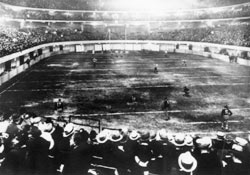
The 1932 NFL Playoff Game was an extra game held to break a tie in the 1932 season's final standings in the National Football League. It matched the host Chicago Bears and the Portsmouth Spartans. Because of snowfall and anticipated extremely cold temperatures in Chicago, Illinois, it was moved indoors and played at the three-year-old Chicago Stadium on December 18 on a reduced-size field on Sunday night.

A comparison of American football and rugby union is possible because of the games' shared origins, despite their dissimilarities.
A comparison between American football and rugby league is possible because of their shared origins and similar game concepts. Rugby league is arguably the most similar sport to American football after Canadian football: both sports involve the concept of a limited number of downs/tackles and scoring touchdowns/tries takes clear precedence over goal-kicking.

A field goal (FG) is a means of scoring in gridiron football. To score a field goal, the team in possession of the ball must place kick, or drop kick, the ball through the goal, i.e., between the uprights and over the crossbar. American football requires that a field goal must only come during a play from scrimmage, while Canadian football retains open field kicks and thus field goals may be scored at any time from anywhere on the field and by any player. The vast majority of field goals, in both codes, are place kicked. Drop kicked field goals were common in the early days of Gridiron football but are almost never done in modern times. In most leagues, a successful field goal awards three points.

The rectangular field of play of American football games measures 100 yards (91.44 m) long between the goal lines, and 160 feet (48.8 m) wide. In addition, there are end zones extending another 10 yards (9.144 m) past the goal lines to the "end lines", for a total length of 120 yards (109.7 m). When the "football field" is used as unit of measurement, it is usually understood to mean 100 yards (91.44 m), although technically the full length of the official field, including the end zones, is 120 yards (109.7 m).
The following terms are used in American football, both conventional and indoor. Some of these terms are also in use in Canadian football; for a list of terms unique to that code, see Glossary of Canadian football.
Field goal range is the part of the field in American football where there is a good chance that a field goal attempt will be successful.
